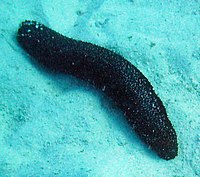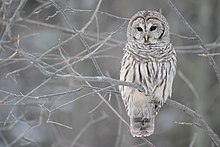Deuterostome
| Deuterostomes Temporal range: Ediacaran - Recent
| |
|---|---|

| |
| Sea cucumbers and other echinoderms are deuterostomes. | |
| Scientific classification | |
| Domain: | |
| Kingdom: | |
| Subkingdom: | |
| (unranked): | |
| Superphylum: | Deuterostomia Grobben, 1908
|
| Phyla | |
Deuterostomes (taxonomic term: Deuterostomia; from the Greek: "second mouth") are a superphylum of animals. They are a subtaxon of the Bilateria branch of the subregnum Eumetazoa, and are opposed to the protostomes. Deuterostomes are distinguished by their embryonic development; in deuterostomes, the first opening (the blastopore) becomes the anus, while in protostomes it becomes the mouth. Deuterostomes are also known as enterocoelomates because their coelom develops through enterocoely.
There are four extant phyla of deuterostomes:
- Phylum Chordata (vertebrates and their kin)
- Phylum Echinodermata (sea stars, sea urchins, sea cucumbers, etc.)
- Phylum Hemichordata (acorn worms and possibly graptolites)
- Phylum Xenoturbellida (2 species of worm-like animals)[citation needed]
Superphylum Deuterostomia was redefined in 1995 based on molecular sequence analyses when the lophophorates were removed from it and combined with other protostome animals to form superphylum Lophotrochozoa.[1] The phylum Chaetognatha (arrow worms) may also belong here. Extinct groups may include the phylum Vetulicolia. Echinodermata, Hemichordata and Xenoturbellida form the clade Ambulacraria.[2] The present phylum Priapulida also has a deuterostomic development, despite being otherwise placed within the protostomes.[3]

In both deuterostomes and protostomes, a zygote first develops into a hollow ball of cells, called a blastula. In deuterostomes, the early divisions occur parallel or perpendicular to the polar axis. This is called radial cleavage, and also occurs in certain protostomes, such as the lophophorates. Most deuterostomes display indeterminate cleavage, in which the developmental fate of the cells in the developing embryo are not determined by the identity of the parent cell. Thus if the first four cells are separated, each cell is capable of forming a complete small larva, and if a cell is removed from the blastula the other cells will compensate.
In deuterostomes the mesoderm forms as evaginations of the developed gut that pinch off, forming the coelom. This is called enterocoely.
Both the Hemichordata and Chordata have gill slits, and primitive fossil echinoderms also show signs of gill slits. A hollow nerve cord is found in all chordates, including tunicates (in the larval stage). Some hemichordates also have a tubular nerve cord. In the early embryonic stage it looks like the hollow nerve cord of chordates. Because of the degenerated nervous system of echinoderms, it is not possible to discern much about their ancestors in this matter, but based on different facts it is quite possible that all the present deuterostomes evolved from a common ancestor that had pharyngeal gill slits, a hollow nerve cord, circular and longitudinal muscles and a segmented body.[4] It could have resembled the small group of Cambrian deuterostomes named Vetulicolia.
Formation of mouth and anus

The defining characteristic of the deuterostome is the fact that the blastopore (the opening at the bottom of the forming gastrula) becomes the anus, whereas in protostomes the blastopore becomes the mouth. The deuterostome mouth develops at the opposite end of the embryo from the blastopore and a digestive tract develops in the middle connecting the two.
Origins
The majority of animals more complex than jellyfish and other Cnidarians are split into two groups, the protostomes and deuterostomes. Chordates (which include all the vertebrates) are deuterostomes.[5] It seems very likely that 555 million years old Kimberella was a member of the protostomes.[6][7] If so, this means that the protostome and deuterostome lineages must have split some time before Kimberella appeared — at least 558 million years ago, and hence well before the start of the Cambrian 538.8 million years ago.[5] The Ediacaran fossil Ernietta, from about 549 to 543 million years ago, may represent a deuterostome animal.[8]
Fossils of one major deuterostome group, the echinoderms (whose modern members include sea stars, sea urchins and crinoids) are quite common from the start of Series 2 of the Cambrian, 521 million years ago.[9] The Mid Cambrian fossil Rhabdotubus johanssoni has been interpreted as a pterobranch hemichordate.[10] Opinions differ about whether the Chengjiang fauna fossil Yunnanozoon, from the earlier Cambrian, was a hemichordate or chordate.[11][12] Another Chengjiang fossil, Haikouella lanceolata, also from the Chengjiang fauna, is interpreted as a chordate and possibly a craniate, as it shows signs of a heart, arteries, gill filaments, a tail, a neural chord with a brain at the front end, and possibly eyes — although it also had short tentacles round its mouth.[12] Haikouichthys and Myllokunmingia, also from the Chengjiang fauna, are regarded as fish.[13][14] Pikaia, discovered much earlier but from the Mid Cambrian Burgess Shale, is also regarded as a primitive chordate.[15] On the other hand fossils of early chordates are very rare, since non-vertebrate chordates have no bones or teeth, and none have been reported for the rest of the Cambrian.
Implications in cancer patient survival genes
A new study [16] using TCGA mutation and clinical data of >3,000 patients identifies a core cancer patient survival network. Many genes in this survival network merged at Metazoa or later, and probably not coincidentally at Deuterostomia. Deuterostomia are characterised by their plastic ability in cell-fate determination that they acquired but is absent in preceding ancestors. The most parsimonious explanation for acquisition of such plasticity is to create de novo highly mutable genes with broad effects on cell fate. Partially because of the high mutability in different cell/tumour types, and in part because of their essentiality in evolution, genes first created at Deuterostomia are more likely to be now affecting cancer patient survivalness.
References
- ^ Halanych, K.M., Bacheller, J., Liva, S., Aguinaldo, A. A., Hillis, D.M. and Lake, J.A. (1995). "18S rDNA evidence that the Lophophorates are Protostome Animals". Science. 267 (5204): 1641–1643. Bibcode:1995Sci...267.1641H. doi:10.1126/science.7886451. PMID 7886451.
{{cite journal}}: CS1 maint: multiple names: authors list (link) - ^ Bourlat S. J., Juliusdottir T., Lowe C. J., Freeman R., Aronowicz J., Kirschner M., Lander E. S., Thorndyke M., Nakano H.; et al. (2006). "Deuterostome phylogeny reveals monophyletic chordates and the new phylum Xenoturbellida". Nature. 444 (7115): 85–88. Bibcode:2006Natur.444...85B. doi:10.1038/nature05241. PMID 17051155.
{{cite journal}}: Explicit use of et al. in:|author=(help)CS1 maint: multiple names: authors list (link) - ^ Deuterostomic Development in the Protostome Priapulus caudatus
- ^ "Cambrian problematica and the diversification of deuterostomes". Biomedcentral.com. Retrieved 2014-08-25.
- ^ a b Erwin, Douglas H.; Eric H. Davidson (1 July 2002). "The last common bilaterian ancestor". Development. 129 (13): 3021–3032. PMID 12070079.
{{cite journal}}: CS1 maint: multiple names: authors list (link) - ^ Vickers-Rich, Patricia; Komarower, Patricia, eds. (2007), The Rise and Fall of the Ediacaran Biota, Special publications, vol. 286, London: Geological Society, ISBN 978-1-86239-233-5, OCLC 156823511
- ^ Butterfield, N.J. (2006). "Hooking some stem-group "worms": fossil lophotrochozoans in the Burgess Shale". BioEssays. 28 (12): 1161–6. doi:10.1002/bies.20507. PMID 17120226.
- ^ Dzik , J. (June 1999). "Organic membranous skeleton of the Precambrian metazoans from Namibia". Geology. 27 (6): 519–522. Bibcode:1999Geo....27..519D. doi:10.1130/0091-7613(1999)027<0519:OMSOTP>2.3.CO;2. Retrieved 2008-09-22. Ernietta is from the Kuibis formation, approximate date given by Waggoner, B. (2003). "The Ediacaran Biotas in Space and Time". Integrative and Comparative Biology. 43 (1): 104–113. doi:10.1093/icb/43.1.104. PMID 21680415. Retrieved 2008-09-22.
- ^ Bengtson, S. (2004). Lipps, J.H., and Waggoner, B.M. (ed.). "Neoproterozoic–Cambrian Biological Revolutions" (PDF). Paleontological Society Papers. 10: 67–78. Retrieved 2008-07-18.
{{cite journal}}:|contribution=ignored (help)CS1 maint: multiple names: editors list (link) - ^ Bengtson, S., and Urbanek, A. (October 2007). "Rhabdotubus, a Middle Cambrian rhabdopleurid hemichordate". Lethaia. 19 (4): 293–308. doi:10.1111/j.1502-3931.1986.tb00743.x. Retrieved 2008-09-23.
{{cite journal}}: CS1 maint: multiple names: authors list (link) - ^ Shu, D., Zhang, X. and Chen, L. (April 1996). "Reinterpretation of Yunnanozoon as the earliest known hemichordate". Nature. 380 (6573): 428–430. Bibcode:1996Natur.380..428S. doi:10.1038/380428a0. Retrieved 2008-09-23.
{{cite journal}}: CS1 maint: multiple names: authors list (link) - ^ a b Chen, J-Y., Hang, D-Y., and Li, C.W. (December 1999). "An early Cambrian craniate-like chordate". Nature. 402 (6761): 518–522. Bibcode:1999Natur.402..518C. doi:10.1038/990080. Retrieved 2008-09-23.
{{cite journal}}: CS1 maint: multiple names: authors list (link) - ^ Shu, D-G., Conway Morris, S., and Han, J.; et al. (January 2003). "Head and backbone of the Early Cambrian vertebrate Haikouichthys". Nature. 421 (6922): 526–529. Bibcode:2003Natur.421..526S. doi:10.1038/nature01264. PMID 12556891. Retrieved 2008-09-21.
{{cite journal}}: Explicit use of et al. in:|author=(help)CS1 maint: multiple names: authors list (link) - ^ Shu, D-G., Conway Morris, S., and Zhang, X-L. (November 1999). "Lower Cambrian vertebrates from south China" (PDF). Nature. 402 (6757): 42. Bibcode:1999Natur.402...42S. doi:10.1038/46965. Retrieved 2008-09-23.
{{cite journal}}: CS1 maint: multiple names: authors list (link) - ^ Shu, D-G., Conway Morris, S., and Zhang, X-L. (November 1996). "A Pikaia-like chordate from the Lower Cambrian of China". Nature. 384 (6605): 157–158. Bibcode:1996Natur.384..157S. doi:10.1038/384157a0. Retrieved 2008-09-23.
{{cite journal}}: CS1 maint: multiple names: authors list (link) - ^ Attention: This template ({{cite doi}}) is deprecated. To cite the publication identified by doi:10.1186/s13073-014-0064-8, please use {{cite journal}} (if it was published in a bona fide academic journal, otherwise {{cite report}} with
|doi=10.1186/s13073-014-0064-8instead.
